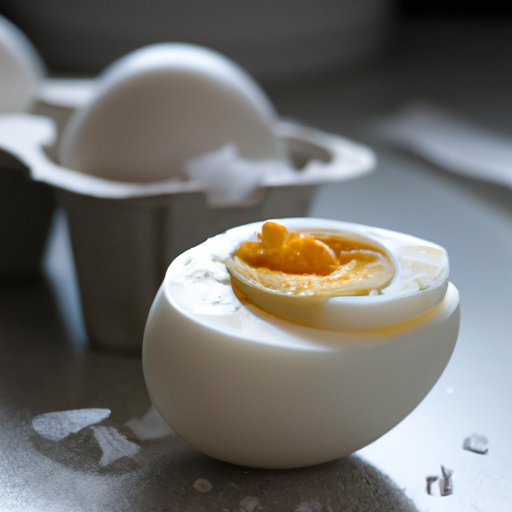Introduction
Hard-boiled eggs are a staple food in many households, especially during the breakfast meal. However, it can be frustratingly challenging to make them perfectly every time. Some people end up with overcooked or undercooked eggs or find it challenging to peel the shell off the egg without damaging it. This article will provide a step-by-step guide to making perfect hard-boiled eggs, along with tips and tricks for the best results.
Step-by-Step Guide to Making Perfect Hard-Boiled Eggs
The boiling method is the most popular technique for making hard-boiled eggs. Follow these simple steps for the perfect boiled egg:
- Place eggs in a saucepan and add cold water that covers the eggs by an inch or two.
- Bring the water to a rolling boil.
- Turn off the heat and cover the saucepan with a lid.
- Let the eggs sit in the hot water for 9 to 12 minutes, depending on how firm you want the yolk to be.
- Remove the eggs from the hot water using a slotted spoon and transfer them to a bowl of ice water.
- Let them cool for 5 minutes, then peel and enjoy!
The preparation time for hard-boiled eggs is minimal, but it’s essential to consider the boiling time and cooling time for perfect eggs.
Tricks and Tips for Hard-Boiling Eggs Perfectly Every Time
Aside from using the right technique, there are other tricks and tips you can use to achieve perfect hard-boiled eggs every time.
Choosing the Right Eggs
The type of eggs you choose can affect the outcome of your hard-boiled eggs. Always choose fresh eggs with no visible cracks, as this can prevent leaking or contamination. Eggs that are at least a week old are easier to peel than fresh ones, too.
Adding an Ingredient for Easier Peeling
Adding one teaspoon of baking soda to the water can help eggs separate more easily from the shell when you’re peeling. However, take care not to add too much baking soda because it can affect the taste of the eggs.
Steaming Method as an Alternative to Boiling
If you don’t want to use the boiling method, steaming eggs can be another alternative. Place the eggs on a steaming rack in a pot with boiling water. Put the lid on and steam for 10-12 minutes for best results.
Tips for Preventing Overcooking and Undercooking
Overcooking eggs can lead to that green-grey ring around the yolk, making it less attractive and less appetizing. Conversely, undercooking eggs or not cooking them at the right temperature can lead to raw, unsafe eggs. To avoid both of these choices, follow the boiling method outlined above, and don’t skip the step of transferring the eggs to a bowl of ice water once they’re finished boiling. This helps you stop cooking the eggs and cool them quickly.
Common Mistakes to Avoid When Making Hard-Boiled Eggs
There are a few common mistakes to avoid when making hard-boiled eggs:
Using too much heat
Using too much heat and boiling for too long can lead to undercooked eggs with a runny yolk or overcooked eggs. The boiling method does not require high heat. It only requires a low-heat simmer to regulate the cooking process.
Not enough cooling
If you don’t use ice water to cool the eggs correctly, they will continue cooking in the residual heat. This can lead to overcooked eggs and darken the yolk, making them less appetizing.
To avoid these mistakes, pay attention to the boiling method above, and don’t forget to use ice water to stop the cooking process.
How to Tell If an Egg is Perfectly Hard-Boiled or Still Raw
The standard method of checking for doneness is to remove an egg from the pot and gently tap it on a hard surface. After cooling, you can roll it gently across the surface to see if it moves. For overcooked eggs, the yolk can be fully or partially green, and the egg white can appear dry and chalky.
For medium-boiled eggs, the yolk may be slightly runny in the center, while hard-boiled eggs should have a firm yolk that is yellow throughout. Once you’re comfortable with the process of making the perfect hard-boiled egg, learn how to peel the egg without damaging it.
Creative Recipes Using Hard-Boiled Eggs as a Key Ingredient
Hard-boiled eggs are versatile and can be used in many different dishes, from salads to sandwiches. Here are some creative recipes to try:
Egg Salad Sandwich
Mix chopped hard-boiled eggs, mayo, mustard, salt, and pepper to make a delicious egg salad. Serve it in a sandwich with lettuce and sliced tomato.
Cobb Salad
Combine hard-boiled eggs, bacon, avocado, tomato, and crumbled blue cheese over a bed of lettuce. Dress with your favorite vinaigrette for a filling and flavorful salad.
Deviled Eggs
Halve hard-boiled eggs, mix the yolks with mayo, mustard, and paprika, and pipe it back into the egg whites. Perfect bite-sized appetizers that are easy to make and delicious!
Conclusion
Mastering the art of the perfect hard-boiled eggs is a valuable skill to have. It’s an affordable and healthy option for breakfast, lunch, or snacks. With the tips and tricks outlined in this article, you will be able to impress family and friends with the perfect hard-boiled eggs.
Remember to follow the boiling method outlined above, use ice water to cool the eggs, and choose fresh eggs. Also, try out different creative recipes with hard-boiled eggs.
Keep in mind the common mistakes to avoid when making hard-boiled eggs, and learn how to tell if an egg is perfectly cooked.
